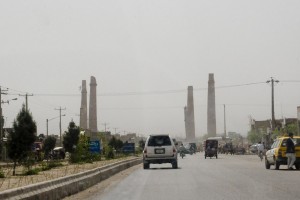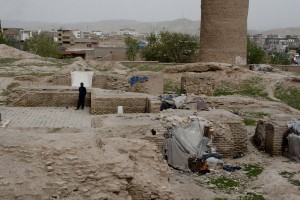Herat part 1
March 25th, 2010
Just back from a short trip to Herat, an ancient cultural center located on the Harīrūd river in western Afghanistan. First settled five thousand years ago, Herat has always been regarded as the cradle of Afghan civilization, Like in Egypt, as one flies over sandy wastelands, a straight line changes the landscape to one of irrigated green fields and trees.
Shakila, the woman who visited us last summer invited me to spend the Now Ruz (New Year) holiday with her old friend from nursing school, Soleha, her husband Ali, and their 4 year old daughter, Munis. They live in a nice apartment with gorgeous pink marble stairs, two bedrooms, a “squat and squirt” toilet and no internet. Soleha has become a midwife and has opened her own midwife clinic/pharmacy. (One item she sells at the pharmacy is Happiness brand Depo Prevara.) She cares for her family during the day until 4pm when she opens her clinic. Assistants at the clinic watch Munis while she works. The day Shakila and I visited, she had a non-stop flow of patients for pre-natal care, birth control, gyn issues and post-partum check ups. Lab work takes weeks to return and she doesn’t do routine pap smears. She says that the women prefer her to a doctor because she takes the time to listen to them and if she doesn’t know something, she works hard to find out.
The following day we went touring around. The mosque and seminary complex completed by Queen Gowhar Shad in 1418 is now rubble with only five towering pillars remaining. Among the dirt hillocks and low mud brick walls remaining, heroin addicts have fashioned huts out of rubble.
Gazar Gah is the burial place of Ansari of Herat, a renowned and well-loved Sufi poet who died in 1088.
Here is one of his poems:
Give Me
 |
by Khwaja Abdullah Ansari (1006 – 1088) TimelineEnglish version by Andrew Harvey Original Language |
|
O Lord, give me a heart
I can pour out in thanksgiving.
Give me life
So I can spend it
Working for the salvation of the world.
Inside this shrine and others also offer an oasis where women can gather to visit with each other in this conservative city where there are few places for women to “hang out” in public.
Next we visited the Haji Galton Wali shrine, also known as the shrine of the “Rolling Saint”. When I visited here in ’03, it was full of men and I was told to come back on a “women’s day”, which I couldn’t do. This day there were only a few people, so I took the opportunity to give it a try. My attitude was that I don’t believe in it, but I don’t disbelieve, either. I lay my head on a stone for that purpose, crossed my ankles, made a wish and the shrine-lady there gave me a push to start me rolling. It didn’t really work. The few rolls I did took effort. I took that to mean that I wasn’t going to get my wish. I changed wishes and this time once I got started, it felt as though I were rolling down a gentle hill. I came to a stop in the middle of the “yard” and wondered if I could roll more so I tried to continue to roll under my own effort. This time it was hard, not natural like the rolling was earlier.





